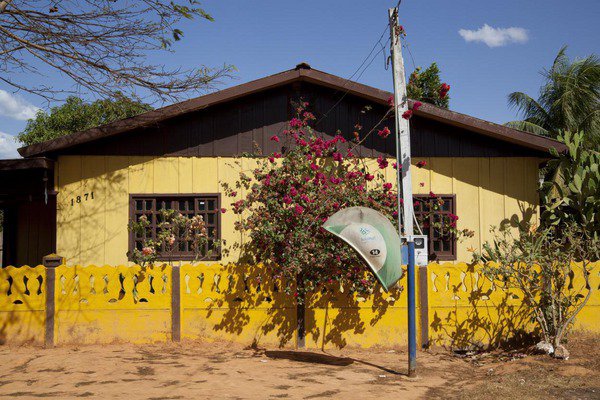Sergio Vega
dal 1/2/2013 al 5/4/2013
Segnalato da
1/2/2013
Sergio Vega
Galerie Karsten Greve, Paris
July 14th, The 4 Steps of a Rooster Manifesto and Other Stories... The exhibition offers numerous photographs in small and large format addressing subjects as varied as urban landscapes and the Amazon forest.

The Karsten Greve Gallery is pleased to present the exhibition Sergio Vega – July 14th, 4 Steps of a
Flâneur Rooster Manifesto and Other Stories... The exhibition offers numerous photographs in
small and large format addressing subjects as varied as urban landscapes and the Amazon forest.
Attentive to the cultural and social dynamics that surround him, Sergio Vega (Argentine, 1959) has
been developing a project since 1995 entitled “El Paraíso en el Nuevo Mundo” (Paradise in the New
World). He took his inspiration from a book written in 1650 by Antonio de Leo Pinelo, a Spanish
historian who placed the Garden of Eden in Latin America. Sergio Vega questions this idea of
terrestrial paradise: his research has thus lead him to the Mato Grosso, in Brazil, where he went to
examine and reinterpret this theory. This ambitious project lead the artist to produce a growing
number of photographs, sculptures, videos and other works inspired by texts that document his
journey in search of Pinelo’s paradise. Vega invites the spectator to entertain a new interpretation. He
creates works that interrogate the systems of intercultural representation that are both contemporary
and historical. His works have the value of intimate diaries, bearing witness to his travels and
adventures, whether they are documentary, ironic or poetic.
The photographs of Amazonian houses invite reflection on human intervention on the natural
environment and the creation of social structures that derive from this artifice. In the work July 14th,
the politico-social critique is a direct link to French history. On a dusty morning of the 121 st
anniversary of the Revolution, Sergio Vega went to the Amazonian village of Claudia where he
discovered a brightly coloured house, which drew his attention. This vision suddenly undertakes a
collection of mysterious and unexpected references to the Paris Commune, the year of which, 1871,
is inscribed in the façade of the house and is also a reference to Napoleon. The shape of the public
telephone cabin in front of the house reminded Vega of a caricature of Napoleon that he discovered
by chance in Paris in a bookshop near Saint Michel. The artist seeks to take hold of the symbols in
this photograph and highlights the commemorative role of this artistic medium capable of reviving
the revolutionary spirit. So by mixing theory, personal experience and critique of society’s structures,
Vega manages to create a world where sensorial experience and argumentative views meet.
The role that this project covers in Sergio Vega’s work reveals the importance the artist ascribes to
wild nature as a metaphor for paradise. The works taken from the series « Mist in the Forest » (2010)
address the notion of iconography in nature.
These photographs of the forest in fog and mist refer
back to the landscape paintings of Romanticism through the intimacy of their formats and their
representation of primeval nature. These photographs of the forest in fog and mist refer back to the
landscape paintings of Romanticism through the intimacy of their formats and their representation of
primeval nature. Taken in its primordial power, this sumptuous and sensual nature evokes the concept
of the sublime, which leads the artist to refer to them as the Sublime Series. With respect to the large
format photographs such as Rubens’ Twist, Dark Forest and Caravaggio’s Moss, Vega chooses to
represent the tropical forest from the perspective of Baroque painting and by allowing himself to be
inspired by the grand masters of Pinelo’s period, such as Caravaggio, Rubens and Rembrandt.
With the series 4 Steps of a Flâneur Rooster Manifesto, Vega develops a photographic narration that
reflects upon the actual condition of art. The rooster moves about in a kind of depot, a mournful
space inhabited by rubbish and rusting metal where he struts without any goal or apparent
conscience. Surrounded by objects conceived as Duchampian ready-mades where the urinal fountain
becomes a toilet, the rooster takes four steps in this chaotic reality: for the artist it is a progression
leading to a symbolic resurrection of the surrealist manifesto.
Sergio Vega’s work can therefore be seen as a kind of rekindling of Surrealism: in response to the
scarcity of contemporary culture, he offers a new reality through which one can let oneself be
seduced – a surrealism of hovels and slums. It is in this unique and multi-referential universe that the
artist invites the spectator to understand the Baudelairean correspondences that surround us, which
only the attentive stroller can grasp.
Sergio Vega was born in Buenos Aires in Argentina in 1959. He lives and works in Gainsville, Florida, where he is a
professor of photography at the University of Florida. Sergio Vega has participated in numerous international exhibitions,
among which the 51st Venice Biennale, the 5th Biennale of Lyon, the 3rd Moscow Biennale, the 2nd Kwangju Biennale and
the 1st Yokohama Triennale. His video The Missing Tail and The Deer (Not the Iguana) was selected for the Worldly
House section of dOCUMENTA (13) in 2012.
Image: Courtesy Galerie Karsten Greve Köln, Paris, St
Moritz
Opening: February 2nd 2013
Karsten Greve Gallery
5, rue Debelleyme - Paris
From Tuesday to Saturday 10am – 7pm
Admission free



